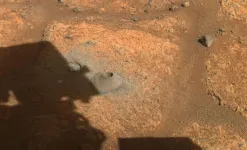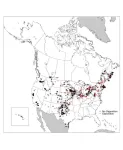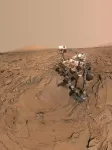(Press-News.org) A brand-new kind of drug, tested in mice, shows promising new results that could lead to the development of a new weight-loss drug that mimics exercise.
The new compound, developed and tested by a University of Florida professor of pharmacy and his colleagues, leads obese mice to lose weight by convincing the body’s muscles that they are exercising more than they really are, boosting the animals’ metabolism.
It also increases endurance, helping mice run nearly 50% further than they could before. All without the mice lifting a paw.
The drug belongs to a class known as “exercise mimetics,” which provide some of the benefits of exercise without increasing physical activity. The new treatment is in the early stages of development but could one day be tested in people to treat diseases like obesity, diabetes, and age-related muscle loss. The research comes as drugs like Ozempic have provided a breakthrough in reducing appetite, helping treat these metabolic diseases.
But the new drug, known as SLU-PP-332, doesn’t affect appetite or food intake. Nor does it cause mice to exercise more. Instead, the drug boosts a natural metabolic pathway that typically responds to exercise. In effect, the drug makes the body act like it is training for a marathon, leading to increased energy expenditure and faster metabolism of fat in the body.
“This compound is basically telling skeletal muscle to make the same changes you see during endurance training,” said Thomas Burris, a professor of pharmacy at UF who led the recent research into the new drug.
“When you treat mice with the drug, you can see that their whole body metabolism turns to using fatty acids, which is very similar to what people use when they are fasting or exercising,” Burris added. “And the animals start losing weight.”
With a team of researchers at Washington University in St. Louis and St. Louis University, Burris published his findings Sept. 22 in the Journal of Pharmacology and Experimental Therapeutics.
The new drug targets a group of proteins in the body known as ERRs, which are responsible for activating some of the most important metabolic pathways in energy-gobbling tissues like muscles, the heart, and the brain. The ERRs are more active when people exercise, but they have proven difficult to activate with drugs.
In another paper published in March, the researchers reported that they had successfully designed SLU-PP-332 to boost activity of the ERRs. They also observed that the compound allowed normal-weight mice to run for 70% longer and 45% further than mice not receiving the drug.
In their latest research, the team tested the drug on obese mice. Treating obese mice twice a day for a month caused them to gain 10 times less fat than untreated mice and lose 12% of their body weight. Yet the mice kept eating the same amount of food and didn’t exercise any more.
“They use more energy just living,” Burris said.
In other work the Burris lab is about to publish, the researchers have seen evidence that the compound can also treat heart failure in mice by strengthening the heart muscle.
So far, the drug hasn’t generated any severe side effects. The next step in developing SLU-PP-332 into a drug candidate will be to refine its structure, ideally making it available as a pill instead of an injection. Then the drug would be tested for side effects in more animal models before making the jump to human trials.
Other exercise mimetics have been tested, but none have made it to market, in part because it takes years to develop a new drug. Targeting obesity, specifically, with a drug has historically been difficult because of how complex obesity is. That was until Ozempic, Wegovy, and Mounjaro, developed to treat diabetes, also caused people to lose weight. This development led to a surge of interest, research, and funding for drugs that could treat these metabolic diseases through different biological pathways.
Burris says the greatest hope for the new drug might be in maintaining muscle mass during weight loss – which often threatens lean muscle mass – or during aging, when the body naturally responds less strongly to exercise. But it will take more research to understand the drug’s full potential.
“This may be able to keep people healthier as they age,” Burris said.
END
Exercise-mimicking drug sheds weight, boosts muscle activity in mice
2023-09-25
ELSE PRESS RELEASES FROM THIS DATE:
Did life exist on Mars? Other planets? With AI's help, we may know soon
2023-09-25
Scientists have discovered a simple and reliable test for signs of past or present life on other planets – “the holy grail of astrobiology.”
In the journal Proceedings of the National Academy of Sciences, a seven-member team, funded by the John Templeton Foundation and led by Jim Cleaves and Robert Hazen of the Carnegie Institution for Science, reports that, with 90% accuracy, their artificial intelligence-based method distinguished modern and ancient biological samples from those of abiotic origin.
“This routine analytical method has the potential to revolutionize ...
Wind energy projects in North America are more likely to be opposed by white, wealthy communities
2023-09-25
(Santa Barbara, Calif.) — Wind energy is, by far, the most common type of clean energy. And transitioning to clean energy is critical to addressing the climate crisis. Yet local opposition poses a significant barrier to the deployment of wind energy projects.
A study published in Proceedings of the National Academy of Sciences (PNAS) by researchers from UC Santa Barbara, the University of Michigan and Gallup Inc. examined wind energy projects throughout the United States and Canada to determine how common opposition is and what factors predict it. The study found that nearly one in five projects faced opposition ...
Naming and shaming can be effective to get countries to act on climate
2023-09-25
Enforcement is one of the biggest challenges to international cooperation on mitigating climate change in the Paris Agreement. The agreement has no formal enforcement mechanism; instead, it is designed to be transparent so countries that fail to meet their obligations will be named and thus shamed into changing behavior. A new study from the University of California San Diego's School of Global Policy and Strategy shows that this naming-and-shaming mechanism can be an effective incentive for many countries to uphold their pledges ...
Scientists develop method of identifying life on other worlds
2023-09-25
Humankind is looking for life on other planets, but how will we recognise it when we see it? Now a group of US scientists have developed an artificial-intelligence-based system which gives 90% accuracy in discovering signs of life.
The work was presented to scientists for the first time at the Goldschmidt Geochemistry Conference in Lyon on Friday 14th July, where it received a positive reception from others working in the field. The details have now been published in the peer-reviewed journal PNAS (see notes for details).
Lead researcher Professor Robert Hazen, of the Carnegie Institution’s Geophysical ...
Caribbean parrots thought to be endemic are actually relicts of millennial-scale extinction
2023-09-25
In a new study published in PNAS, researchers have extracted the first ancient DNA from Caribbean parrots, which they compared with genetic sequences from modern birds. Working with fossils and archaeological specimens, they showed that two species thought to be endemic to particular islands were once more widespread and diverse. The results help explain how parrots rapidly became the world’s most endangered group of birds, with 28% of all species considered to be threatened. This is especially true for parrots that inhabit islands.
On ...
CSIC contributes to deciphering the enigmatic global distribution of fairy circles
2023-09-25
One of the most impressive and mysterious natural formations that we can observe in the arid areas of our planet are the fairy circles. These are enigmatic circular patterns of bare soil surrounded by plants generating rings of vegetation, which until now had only been described in Namibia and Australia. Over the years, multiple hypotheses have been proposed to explain their formation, which have given rise to numerous discussions about the mechanisms that give rise to them. However, until now, we did not know the global dimension of this type of phenomena and the environmental ...
Insilico Medicine and University of Cambridge present new approach to discover targets for Alzheimer’s and other diseases with protein phase separation
2023-09-25
New York and Cambridge, UK -- Recent research demonstrates that protein phase separation (PPS) is widely present in cells and drives a variety of important biological functions. Protein phase separation at the wrong place or time could create clogs or aggregates of molecules linked to neurodegenerative diseases like Alzheimer’s and Parkinson’s, and poorly formed cellular condensates could contribute to cancers and might help explain the aging process.
Given the emerging association between human disease and the PPS process, scientists have been looking for ways to identify potential targets for therapeutic interventions based on PPS regulation. Today, Insilico ...
Antibiotics can help some bacteria survive for longer
2023-09-25
Scientists have found a surprising effect of some antibiotics on certain bacteria – that the drugs can sometimes benefit bacteria, helping them live longer.
Until now, it has been widely acknowledged that antibiotics kill bacteria or stop them growing, making them widely used as blanket medication for bacterial infections. In recent years, the rise of antibiotic resistance has stopped some antibiotics from working, meaning that untreatable infections could be the biggest global cause of death by 2050.
Now, researchers at the University of Exeter have shown for the first time that antibiotics ...
New method can improve assessing genetic risks for non-white populations
2023-09-25
A team led by researchers at Johns Hopkins Bloomberg School of Public Health and the National Cancer Institute has developed a new algorithm for genetic risk-scoring for major diseases across diverse ancestry populations that holds promise for reducing health care disparities.
Genetic risk-scoring algorithms are considered a promising method to identify high-risk groups of individuals who could benefit from preventive interventions for various diseases and conditions, such as cancers and heart diseases. ...
Wearable devices show who may need more help managing diabetes
2023-09-25
A new Dartmouth study in the journal Science Advances suggests that how well people with diabetes manage their blood sugar depends on their experience with the condition and their overall success in controlling their glucose levels, as well as on the season and time of day. The findings could help physicians identify those patients who could benefit from more guidance in regulating their blood sugar, particularly at certain times of year.
The researchers accessed data from wearable glucose monitors that showed how 137 people in the U.S. aged 2 to 76 living primarily with type 1, aka juvenile, diabetes managed their blood sugar on a daily basis. By analyzing more ...






